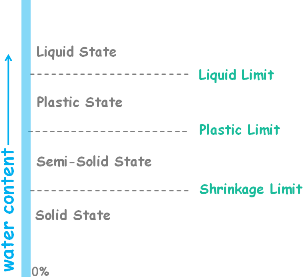 Consistency is a term which is used to describe the degree of firmness of soil. It is indicated by terms such as soft, medium and hard. Depending upon the water content soil may appear in one of these four states.
Consistency is a term which is used to describe the degree of firmness of soil. It is indicated by terms such as soft, medium and hard. Depending upon the water content soil may appear in one of these four states.
Liquid State
Plastic State
Semi Solid State and
Solid State
Consistency limits are water content at which the soil changes from one of these states to another. These limits are:
Liquid Limit
Plastic Limit
Shrinkage Limit
In liquid state water content of the soil is such that it behaves like liquid and offers no resistance to flow.
When water content of this soil drops it starts gaining shear strength and slowly develops resistance to flow. At water content named as liquid limit soil gains infinitesimal shear strength. Here soil stops being liquid and enters into a state called plastic state of soil.
 In plastic state soil can be moulded in any shape due to a property called plasticity.
In plastic state soil can be moulded in any shape due to a property called plasticity.
Plasticity is an important index property of fine grained soils, especially clayey soils.
Plasticity in case of soil refers to the property of soil to get deformed without cracking or fracturing under the action of external force and remain deformed after the removal of that force.

Plasticity is exhibited by a soil due to the clay minerals present in it. These clay particles carry negative charges on their surface. Water molecules, that are dipolar, are attracted towards this negatively charged surface and form a water layer around clay particles. This phenomenon is known as adsorption with the D of the water and the water so attracted is called adsorbed water.
 The clay particles are separated by layers of water which allow them to slip over one another. When the soil is subjected to deformations, soil particles move to different positions and after the removal of the deformation force, they do not return to their original positions. Hence these deformations are irreversible which we say they are plastic.
The clay particles are separated by layers of water which allow them to slip over one another. When the soil is subjected to deformations, soil particles move to different positions and after the removal of the deformation force, they do not return to their original positions. Hence these deformations are irreversible which we say they are plastic.
The presence of adsorbed water is necessary to impart plasticity characteristics to a soil. The soil does not become plastic when it is mixed with a non-polarizing liquid, such as kerosene or paraffin oil.
Also the soil becomes plastic only when it contains clay minerals. If the soil doesn’t have any clay minerals and only contains non clay minerals such as quartz, it would not become plastic whatever may be the fineness of soil or whatever may be the water content. That soil cannot be rolled into threads.
In plastic state soil can be rolled into threads without breaking them and it can be moulded in any shape.
Plasticity of soil is calculated in terms of its water content. As the water content of the soil is reduced the plasticity of the soil is reduced.
While soil is in the plastic state, if we reduce its water content, soil reaches a point below which it stops behaving as plastic material, that water content is called Plastic limit of soil. At this water content soil loses its plasticity.
Below the plastic limit soil begins to crumble when rolled into threads of 3 mm diameter.
We can determine the plastic limit using the soil sample prepared for the liquid limit test.
 For the determination of plastic limit the soil is air dried and sieved through 425 micron IS sieve to get fine grained soil only. Because we know Atterberg limits are only significant for the fine grained soils. 425 micron IS sieve has its mesh openings of 425 micron or 0.425 mm. The particles we get after sieving are all of the size less than 425 micron. These particles include fine sand, silts and clays.
For the determination of plastic limit the soil is air dried and sieved through 425 micron IS sieve to get fine grained soil only. Because we know Atterberg limits are only significant for the fine grained soils. 425 micron IS sieve has its mesh openings of 425 micron or 0.425 mm. The particles we get after sieving are all of the size less than 425 micron. These particles include fine sand, silts and clays.
We take about 30 gm of this sieved soil in an evaporating dish. It is thoroughly mixed with distilled water till it is reached at a consistency at which it can be rolled without sticking to the hands.
We take some amount of this soil mass in hand and form a ball.
Then the ball is placed on the glass plate and rolled between the palm and the glass plate with little pressure to roll the mass into a thread of uniform diameter throughout its length.

The thread shall be further deformed on each stroke so that its diameter reaches 3 mm taking no more than 2 min. We take the reference of a metallic rod for the diameter comparison of the thread.
Normally 80-90 strokes per minute are recommended. We count a stroke as one complete motion of the hand forward and back to the starting position.
If the diameter of the thread becomes smaller than 3 mm, without any crack formation, it shows that soil is in plastic state and its water content is higher than the plastic limit.

Plastic limit is the water content of the soil at which soil just begins to crumble when rolled into threads of 3.2mm or 1/8th of an inch in diameter.
If rolled soil thread does not crumble while reaching at 3 mm diameter then it is kneaded into ball again and its water content is reduced by continuously spreading and mixing the soil on the glass plate.
After that soil is re-rolled into a thread and the procedure of kneading and rolling is repeated until the thread begins to crumble.
Once the thread crumbles, it means that soil has reached its plastic limit. We collect the soil pieces and its water content is determined using any of the water content determination methods. Its water content is noted as W1.
We repeat the whole procedure two more times taking the fresh soil sample each time. We determine the water content W2 and W3 repectively.
Average of these three determined plastic limit water contents is considered as plastic limit of that soil.







